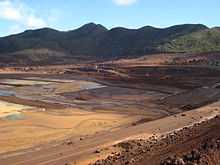Economy of New Caledonia

New Caledonia is a major source for nickel and contains roughly 10% of the worlds known nickel supply. The islands contain about 7,100,000 tonnes of nickel. With the annual production of about 107,000 tonnes in 2009, New Caledonia was the world's fifth largest producer after Russia (266,000), Indonesia (189,000), Canada (181,000) and Australia (167,000).[1] In recent years, the economy has suffered because of depressed international demand for nickel, due to the ongoing global financial crisis. Only a negligible amount of the land is suitable for cultivation, and food accounts for about 20% of imports. In addition to nickel, the substantial financial support from France and tourism are keys to the health of the economy. In the 2000s, large additions were made to nickel mining capacity. The Goro Nickel Plant is expected to be one of the largest nickel producing plants on Earth. When full-scale production begins in 2013 this plant will produce an estimated 20% of the global nickel supply.[2] However, the need to respond to environmental concerns over the country's globally recognized ecological heritage, may increasingly need to be factored into capitalization of mining operations.
The GDP of New Caledonia in 2007 was 8.8 billion US dollars at market exchange rates, the fourth-largest economy in Oceania after Australia, New Zealand, and Hawaii.[3] The GDP per capita was 36,376 US dollars in 2007 (at market exchange rates, not at PPP), lower than in Australia and Hawaii, but higher than in New Zealand.[3]
In 2007, exports from New Caledonia amounted to 2.11 billion US dollars, 96.3% of which were mineral products and alloys (essentially nickel ore and ferronickel).[4] Imports amounted to 2.88 billion US dollars.[4] 26.6% of imports came from Metropolitan France, 16.1% from other European countries, 13.6% from Singapore (essentially fuel), 10.7% from Australia, 4.0% from New Zealand, 3.2% from the United States, 3.0% from Japan, and 22.7% from other countries.[4]
Tourism
As of 2007, about 200 Japanese couples travel to New Caledonia each year for their wedding and honeymoon. Oceania Flash reported in 2007 that one company planned to build a new wedding chapel to accommodate Japanese weddings to supplement the Le Meridien Resort in Nouméa.[5]
New Caledonia is a popular destination for groups of Australian high school students who are studying French.
Facts
GDP (nominal exchange rate): US$8.82 billion (in 2007)[3]
GDP - real growth rate: 4.6% (in 2007)[3]
GDP - per capita (nominal exchange rate): US$36,376 (in 2007)[3]
GDP - composition by sector:
agriculture:
5%
industry:
30%
services:
65% (1997 est.)
Population below poverty line: NA%
Household income or consumption by percentage share:
lowest 10%:
NA%
highest 10%:
NA%
Inflation rate (consumer prices): -0.6% (2000 est.)
Labor force: 78 990 (including 11 300 unemployed, 2004)
Labor force - by occupation: agriculture 20%, industry 20%, services 60% (1999 est.)
Unemployment rate: 17.1% (2004)
Budget:
revenues:
US$856.3 million
expenditures:
US$836.5 million (1996 est.)
Industries: nickel mining and smelting
Industrial production growth rate: -0.6% (1996)
Electricity - production: 1.581 billion kWh (2003)
Electricity - production by source:
fossil fuel:
65.79%
hydro:
34.21%
nuclear:
0%
other:
0% (1998)
Electricity - consumption: 1,47 billion kWh (2003)
Electricity - exports: 0 kWh (1998)
Electricity - imports: 0 kWh (1998)
Agriculture - products: vegetables; beef, deer, other livestock products
Exports: US$2.11 billion (in 2007)[4]
Exports - commodities: ferronickels, nickel ore, fish
Exports - partners: Japan 22.4%, Metropolitan France 15.2%, China 14.2%, Taiwan 13.2%, other European countries 20.5%, Oceania 5.9%, Africa 4.8%, Americas 2.7%, other Asian countries 1.1% (2007)[4]
Imports: US$2.88 billion (in 2007)[4]
Imports - commodities: foods, machinery and equipment, fuels, minerals
Imports - partners: Metropolitan France 26.6%, other European countries 16.1%, Singapore 13.6%, Australia 10.7, New Zealand 4.0%, United States 3.2%, Japan 3.0%, other countries 22.7% (2007)[4]
Debt - external: US$79 million (1998 est.) / €62 million (exchange rate as of 2006-05-07)
Economic aid - recipient: US$770 million from France (1998) / €605 million (exchange rate as of 2006-05-07)
Currency: 1 CFP franc = 100 centimes
Exchange rates: CFP franc per US$1 – 95.89 (2005), 96.04 (2004), 105.66 (2003), 126.71 (2002), 133.26 (2001), 117.67 (January 2000), 111.93 (1999), 107.25 (1998), 106.11 (1997), 93.00 (1996), 90.75 (1995); note - linked at the rate of 1000 CFP to 8.38 euro
Fiscal year: calendar year
References
- ↑ "Nickel" (PDF). USGS. 2011. Retrieved 2011-02-10.
- ↑ Mining-technology.com. "Goro Nickel Project, New Caledonia". Retrieved 2011-02-10.
- ↑ 3.0 3.1 3.2 3.3 3.4 Institut de la statistique et des études économiques de Nouvelle-Calédonie (ISEE). "Chiffres clés" (in French). Retrieved 2011-02-10.
- ↑ 4.0 4.1 4.2 4.3 4.4 4.5 4.6 Institut de la statistique et des études économiques de Nouvelle-Calédonie (ISEE). "Bilan économique et social 2007 - Échanges Extérieurs (on page 23)" (PDF) (in French). Retrieved 2008-05-29.
- ↑ "Plan for new chapel." (Archive) Papua New Guinea Post-Courier. Weekend Edition, Friday 29 January-Tuesday February 2, 2007. Retrieved on 20 August 2013.
See also
| ||||||||||||||
| ||||||||||||||||||||